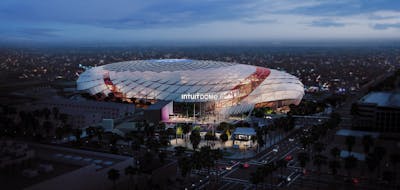
This article by Justin Barton, PE, SE, originally appeared in the June 2023 issue of Modern Steel Construction.
Overview
GEODIS Park, home of Major League Soccer’s Nashville SC, is the largest purpose-built soccer stadium in the United States—and its design prominently features exposed structural steel in an effort to capture Nashville’s industrial roots.
Upon its completion in April 2022—seven weeks ahead of schedule—and officially opening with Nashville SC’s first home game on May 1, 2022, the project helped reinvigorate the Nashville Fairgrounds, a historic and underutilized site a couple of miles south of downtown, bringing new life into the area by spurring new revenues and commercial development.
Design for the 30,000-seat stadium began in earnest in July 2019, with a planned opening 33 months later in May 2022.
To help the stadium capture the heart of Nashville, raise the industry standard for speed and accuracy of project delivery, and open before the start of the 2022 MLS season, Walter P Moore incorporated an innovative structural engineering design by developing a new and fully integrated project delivery process called ConnecTID® or “transformative integrated design for buildings.”
This design approach limited schedule uncertainty, reduced costs and risks for the owner—Metro Nashville Sports Authority—and provided a better outcome for the project stakeholders.
The integrated design process allowed Walter P Moore to maintain design and material quantity control throughout the complex engineering effort and coordinate all areas of design throughout the stadium.
Integrated Design Process
Walter P Moore integrated its design phase construction deliverables into a fabrication-ready level of development (LOD) 400 models for the steel procurement (LOD 400 is the construction stage and includes fabrication, assembly, and installation of components).
The higher-than-standard fidelity and level of completeness of the steel procurement documents resulted in tighter bids, all of which came in 10% to 20% under budget—approximately $3 million in savings.
The architect of record and design architect, Populous, and the design architect, Hastings Architecture, worked in concert with Walter P Moore on the exposed steel connections in a 3D modeling environment to create an elegant and consistent look throughout the stadium.
“Engaging in the fully integrated structural engineering design process gave us the opportunity to have much more control of the look and feel of the steel design and detailing,” said Chris Melander, an architect at Hastings. “Normally, the advanced steel detailing will occur in a vacuum without input from the architect. This process allowed us to be nimbler and make the steel connections a feature of GEODIS Park.”
As a result, the fully integrated structural engineering design process, which occurred in real time, allowed for early and productive coordination among the project team.
“Seeing real-time updates made responding to structural changes fast and efficient, and ultimately led to a more visually appealing and easier-to-deliver product,” said Nikki Smolenski, an architect at Populous.
The process was beneficial to the construction manager Mortenson as well in regard to the steel detailing.
“The fully integrated design process allowed the project team to generate shop drawings earlier than the traditional buy-out method,” said Tom Clark, project executive at Mortenson. “This improved our ability to begin the steel detailing process at the front end of the project.”
Additionally, the early design completion of the connections allowed for early coordination with the bevy of other trades on the project, such as the MEP contractors, which proved to be an effective cost-saving effort. With careful advance coordination, conduit, plumbing, and additional utilities were integrated into the structure while maintaining the structural steel as the main architectural feature (the project incorporates roughly 6,000 tons of structural steel).
“By incorporating the connection design into the scope of the design team, we were able to tailor the connections to the overall design intent, coordinate pathways for stadium utilities without detracting from the beauty of the structure, and begin steel fabrication much sooner than the traditional delivery method,” Melander noted.
The improved deliverables also resulted in fewer change orders, reduced field problems, and improved coordination allowing steel erection to finish weeks ahead of schedule.


